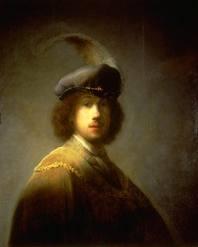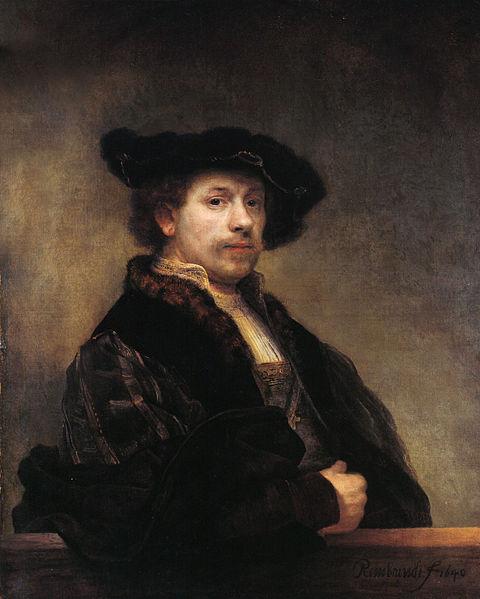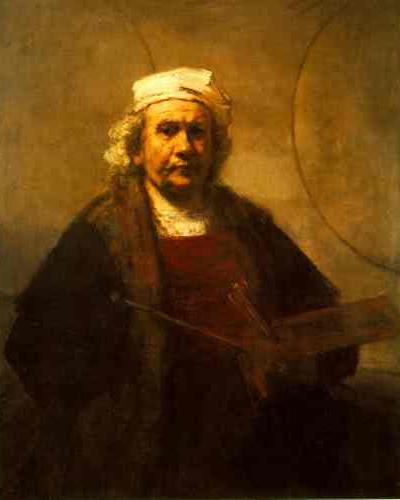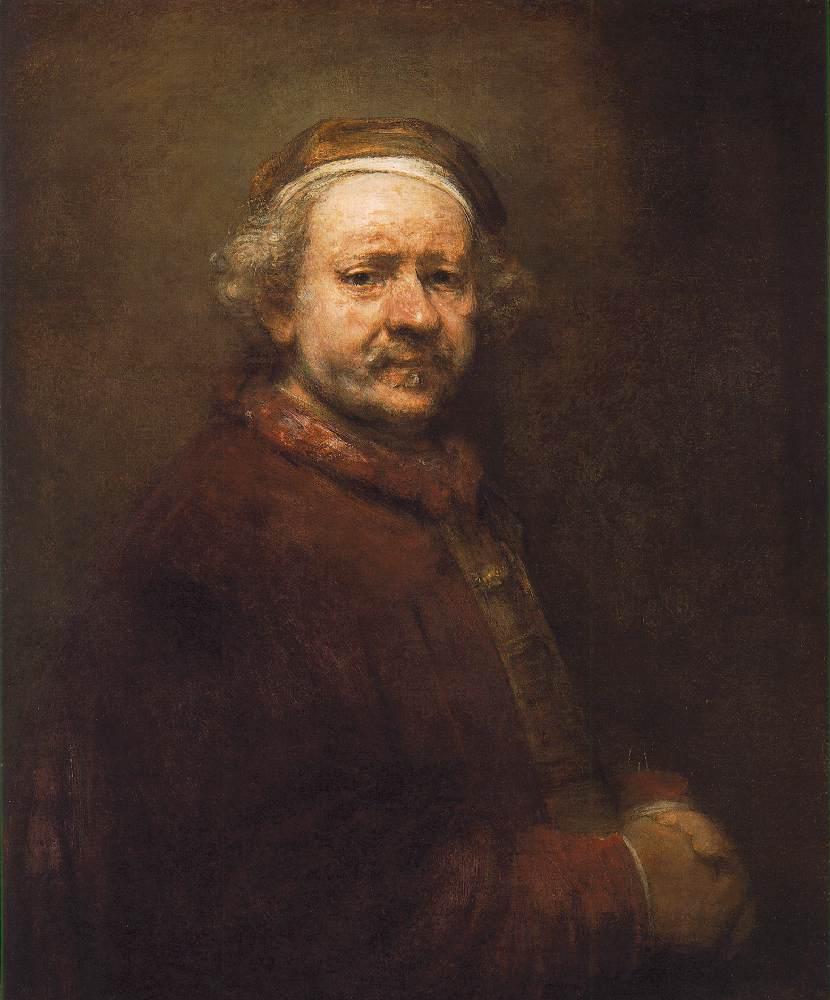 |
 |
 |
 |
 |
"Is there anything in today's paper, Watson?"
Holmes's enquiry was undoubtedly an appeal for something to exercise his mind rather than a desire to know of those great events that create the headlines. The headline today, though, was just the thing to excite my great friend. I answered blandly, however, disguising the importance of the crime.
"Let's see. A Rembrandt has been stolen from the National Portrait Gallery. Hmm, what else?"
"A Rembrandt," said Holmes, sensing the prospect of a case. "Read it all, Watson."
A Rembrandt self-portrait, one of twenty-five on loan from Holland, has been stolen from the National Portrait Gallery. Inspector Lestrade, who is in charge of investigations, has established police surveillance at ports to forestall the painting's removal to the Continent. The Art World fears professional art thieves may be active in this country.
That's all, Holmes. What do you make of it?"
"Clearly professional thieves are not responsible otherwise they would have taken more than one painting. But enough of speculation - Come, Watson, let us go to the scene of the crime."
The National Portrait Gallery is but a short cab-ride from Baker Street yet every minute strained my friend's patience to come to grips with this new challenge.
"Hurry," said Holmes, "the game's afoot."
A police cordon surrounded the Gallery to hold back a crowd of some two hundred spectators. Inspector Lestrade caught sight of us and we were ushered through the throng.
"I am not in the least surprised to see you, Mr Holmes, seeing that you live nearby but I hardly think you need trouble yourself as we expect to make an early arrest."
"Ah, so you have a prime suspect, already, Inspector?"
"Indeed I do, and will soon recover the lost Rembrandt."
"Wonderful! But what, pray tell us, has brought this case toward its speedy conclusion?"
"With pleasure, Holmes, but let us first have a look at the Rembrandts."
As we made our way to the Gallery I recalled that Holmes had once visited the Rijksmuseum, Amsterdam, where he examined several Rembrandt self-portraits. He proved their oil pigments to be from a tiny, yet quite specific source in Leiden that resulted in the date of this group of paintings being revised from 1629 to 1630.
 |
 |
 |
 |
 |
The Rembrandts occupied the length of one wall and were set conveniently at eye level. They were evenly spaced except for a gap that rather obviously had been the location of the stolen painting.
"I see the paintings are in sequence," said Holmes, "with the oldest on the left and the newest on the right."
"That is correct, but how did you know?" asked Lestrade.
"Elementary, my dear Lestrade. The oldest portrait displays the youngest man whereas the painting of Rembrandt as an old man is therefore newer by several decades. How do you find it, Watson? As a medical man does this series, painted from life and spanning nearly fifty years, excite you?"
"Indeed, Holmes, both artistically and academically."
Lestrade was greeted by a middle-aged gentleman whom he then introduced as Sir Rupert Archer, himself a noted portrait painter and curator of the Gallery.
"This is a shocking thing, gentlemen. To have successfully negotiated these wonderful paintings being brought to London only to be dealt such a personal blow is heartbreaking."
"But Inspector Lestrade is expecting to arrest the culprit and to recover the painting. Cannot that ease your despair?"
"Perhaps I ought explain," said Lestrade. "The suspect is Henry Archer, Sir Rupert's twin brother. Both the painting and Henry Archer disappeared at the same time. Sir Rupert and Henry are identical twins although not precisely so. They have very many identical features but unquestionably there are noticeable differences. But you shall be the judge because, as I am sure you know, Sir Rupert is a major artist in his own right and his painting of his brother Henry hangs in an adjoining room. Let us now go there. Would you please guide us, Sir Rupert?"
"My brother is not the most savoury person, Mr Holmes. He travels the world living by his wits and but rarely returns to England. He has his good points or, at least until now, I considered them so. He is an art lover but not an artist. He has been staying with me since three days ago and, not surprisingly, he went to the Rembrandt exhibition. Last night he failed to return as expected. As curator of the gallery I ensure it is locked and bolted after closing time. Because of the importance of the Rembrandt exhibition I am making an additional security check in the late evening. It was during this check that I discovered the painting was missing. I can only assume my brother managed to copy the gallery keys to carry out the theft."
The portrait of Henry Archer was a very fine painting, not to be compared with a Rembrandt but, nevertheless, worthy to grace the spot it now occupied. Differences between Sir Rupert and Henry were subtle but evident. For example, their noses and mouths were not exactly the same. Holmes looked at Sir Rupert and then studied the portrait for a few minutes, clearly making mental notes.
"Though we become aware of certain differences between Sir Rupert and his brother how does this help your investigation?"
"It is anticipated that Henry will try to flee England. He won't get far. About midnight, a witness spoke to a man carrying a painting as he hired a hansom to go to the East End waterfront. The man said his painting was a Rembrandt copy. When the witness was brought here and shown Henry's portrait he identified him as the man. The cabman, too, made the same declaration. Henry's portrait has been copied for distribution nationwide and that coupled with a reward ought to bring about his apprehension."
"You undoubtedly have matters well in hand, Inspector. On behalf of Dr Watson and myself I can only thank you and Sir Rupert for revealing so much detail which will enable us to follow developments with added interest."
"But have you no advice or a suggestion?" asked Lestrade, with just a barely noticeable snigger of sarcasm.
Holmes, who understands Lestrade's slights only too well, ignored it as ever and replied, "A suggestion? Yes - that Sir Rupert's portrait of his brother be placed in the gap formerly occupied by the missing Rembrandt."
"No, no, no," said Sir Rupert, "That would be sacrilege."
"On the contrary, it may well prove instrumental in bringing the villain to justice. When the public come to see the Rembrandts they will also see the picture of Henry Archer. His image will become so fixed in their minds that should he make an appearance he will be instantly recognised."
"I understand. An excellent suggestion. I will personally place it in position within a few minutes."
"Meanwhile, Sir Rupert, perhaps Dr Watson and I might have the pleasure of returning to the Rembrandts."
"By all means, Mr Holmes, please do."
We returned to the exhibition hall and my friend's face revealed his pleasure to be in the presence of these masterpieces. He positively glowed with excitement much as he does whenever he solves a case. By now, the public had been admitted and there was a considerable crowd. Each person would face a painting, have a long look at it, then sidle edgeways, like a crab, to the next painting, and then to the next. It seemed like a strange dance and so amused me that I turned to seek Holmes that he might share the comic scene. Holmes stood behind the line of 'crabs' and his tall, spare frame rose above them. To my surprise, he alone, of all those present, had his back to the Rembrandts! Was Holmes suddenly bored with the exhibits and patiently waiting for me to join him that we might leave?
"What? Have you tired of the exhibition, already, Holmes?"
"On the contrary, Watson, I am enthralled and I will impart to you something you will scarce believe. As you would expect, those who knew Rembrandt in his lifetime knew exactly what he looked like. Since that time, however, I am very likely the one and only person who has ever known what he looked like."
"Holmes, please, that is an incredible statement. Why, before us we have twenty-five of his self-portraits. These people, here and now, see him as have thousands upon thousands of others."
"Twenty-four, actually, Watson. But you know me and you know my methods and you know I do not say what I cannot prove."
"I certainly know your incredible powers of deduction but this leaves me staggering beyond belief even though I know it must be true for my friend says it is so!"
"Watson, my dear fellow, I thank you for your faith but that it not be blind faith I will prove it and you will then become the second person in 300 years who knows what Rembrandt looked like."
"Holmes, this becomes more and more amazing."
"I most certainly do not wish to share this with the public, here or anywhere else, so I will but whisper certain instructions to you but insist you not divulge the slightest reaction. Is that clear?"
"Most clear. Come what may I will not show the least emotion or reaction."
Holmes whispered a few words and I instantly understood the logic of his argument. I was unable to restrain a tiny gasp. It was ever so obvious and ludicrous or even ridiculous that it had passed unnoticed for centuries.
"Now that you know why I am the first you needs must examine the paintings before you can claim to be the second. As I have known the secret for some time I brought the necessary equipment with me. Here, take this and enjoy your research."
It proved a most fascinating exercise: to look again at these magnificent works but this time to see the real Rembrandt was a humbling experience.
I was so completely engrossed in this absorbing adventure that I forgot that this was the scene of a most notorious art theft. Holmes tried to bring me back to reality when he said, "Here comes Sir Rupert with his painting." but I simply continued looking at each portrait in turn. As I scanned across the paintings I eventually came to Sir Rupert hanging his painting between the Rembrandts. I was not able to see his face nor could I see the portrait because all the paintings were at eye level and Sir Rupert stood directly in front of his to complete its hanging and levelling. He then turned and stood to one side to reveal the painting. The next few moments gave me two of the greatest shocks of my life! Standing there was not Sir Rupert but Henry Archer! And the painting was not of Henry Archer but of Sir Rupert!
I turned to Holmes and was met by the widest grin I ever saw in all the years of our friendship.
"And have you solved the case, Watson?"
"Indeed I have, Holmes, thanks to your genius."
"If we had not learnt from Rembrandt we may never have solved it, so perhaps we are a team of three rather than two."
"Indeed, Holmes, though it is you and you alone who solved it."
"When you come to write of this in your casebook call it 'The Rembrandt Trio.' Further, in relating this case do not reveal how it was done. Perhaps a hundred years or so from now it may challenge an enquiring mind and we may be joined by a third person who knows what Rembrandt really looked like!"
"And what of the thief, Holmes?"
"We are not policemen. Leave it to those that are. Come, Watson, there is one Rembrandt we have not yet seen but I think we will be granted a private showing before its restoration to the world."
© 2003, Graeme Lindridge